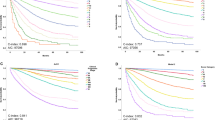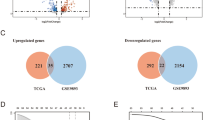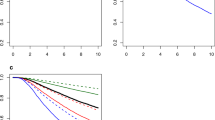Abstract
In breast cancer patients, prognostic information required to plan post-surgical therapy is obtained mainly through axillary dissection. This study was designed to establish a new prognostic score based solely on parameters of the primary tumour as an alternative to axillary surgery in assessing prognosis. Eight different prognostic factors, including menopausal status, tumour size, grading, lymphatic invasion, desmoplasia, necrosis, c-erbB-2 and laminin receptor expression, were evaluated retrospectively on a large series of primary breast carcinoma patients. From multivariate analysis, four independent parameters were selected and examined, alone and in combination, for their prognostic potential. These parameters were used to generate a prognostic score that was analysed retrospectively in 467 N0-N1a patients to determine its predictive value for survival. The score, which includes variables such as tumour size, grading, laminin receptor and c-erbB-2 overexpression, was established based on the number of negative prognostic factors: score 1 refers to cases in which all four parameters reflect a good prognosis, scores 2 and 3 refer to tumours in which, respectively, one or two of the four parameters reflect a poor prognosis, whereas score 4 refers to tumours with three or four poor prognosis factors. Analysis of the overall survival of the four score groups shows that patients with score 1 tumours (22% of the total) had the best prognosis with a 15 year survival of 82%, patients with score 2 and 3 had an intermediate prognosis, whereas score 4 patients had the poorest prognosis with a 15 year survival of only 38%. Moreover, survival in the N+ score 1 cases was found to be longer than that in the total N- patients. Our data suggest that the primary tumour score provides more reliable prognostic information than pathological nodal status, and that axillary dissection can be avoided in a large number of patients.
This is a preview of subscription content, access via your institution
Access options
Subscribe to this journal
Receive 24 print issues and online access
$259.00 per year
only $10.79 per issue
Buy this article
- Purchase on SpringerLink
- Instant access to full article PDF
Prices may be subject to local taxes which are calculated during checkout
Similar content being viewed by others
Author information
Authors and Affiliations
Rights and permissions
About this article
Cite this article
Ménard, S., Bufalino, R., Rilke, F. et al. Prognosis based on primary breast carcinoma instead of pathological nodal status. Br J Cancer 70, 709–712 (1994). https://doi.org/10.1038/bjc.1994.379
Issue Date:
DOI: https://doi.org/10.1038/bjc.1994.379
This article is cited by
-
Questioning the role of axillary node dissection in sentinel node positive early stage breast cancer in the South Eastern Cancer Centre
Irish Journal of Medical Science (1971 -) (2015)
-
Mesenchymal and stemness circulating tumor cells in early breast cancer diagnosis
BMC Cancer (2012)
-
Role of parathymic lymph nodes in metastatic tumor development
Cancer and Metastasis Reviews (2012)
-
Predictive value of bone marrow accumulation of Tc-99m tetrofosmin for subsequent development of distant metastases in breast cancer
Annals of Nuclear Medicine (2007)
-
Factores pronósticos del cáncer de mama. Modelo predictivo
Clinical and Translational Oncology (2004)



